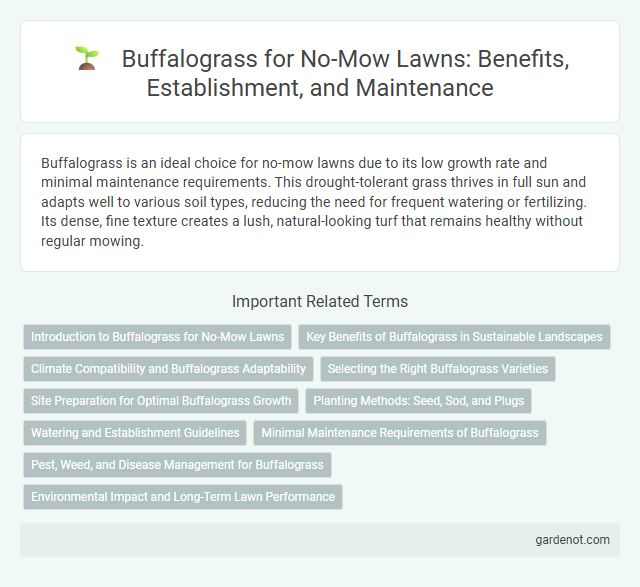Buffalograss is an ideal choice for no-mow lawns due to its low growth rate and minimal maintenance requirements. This drought-tolerant grass thrives in full sun and adapts well to various soil types, reducing the need for frequent watering or fertilizing. Its dense, fine texture creates a lush, natural-looking turf that remains healthy without regular mowing.
Introduction to Buffalograss for No-Mow Lawns
Buffalograss is a drought-tolerant, low-maintenance grass species ideal for no-mow lawns, thriving in warm climates across the Great Plains region. Its deep root system and slow growth rate significantly reduce watering and mowing requirements, promoting sustainable landscaping while conserving water. This warm-season grass also resists pests and diseases, making it a durable and eco-friendly choice for homeowners seeking an attractive, hassle-free lawn.
Key Benefits of Buffalograss in Sustainable Landscapes
Buffalograss requires minimal irrigation, making it highly water-efficient and ideal for drought-prone regions. Its natural resistance to pests and diseases reduces the need for chemical treatments, promoting an eco-friendly lawn. By maintaining a low growth habit, Buffalograss minimizes mowing frequency, lowering carbon emissions associated with lawn maintenance.
Climate Compatibility and Buffalograss Adaptability
Buffalograss thrives in warm, semi-arid climates with full sun exposure and is highly drought-tolerant, making it ideal for regions with hot summers and low rainfall. Its adaptability extends to a wide range of soil types, including sandy and clay soils, while requiring minimal maintenance and irrigation. This grass species maintains its green color through heat stress and can survive cold winters, showcasing exceptional resilience in diverse environmental conditions.
Selecting the Right Buffalograss Varieties
Choosing the right Buffalograss variety depends on regional climate, soil type, and maintenance goals, with popular cultivars like 'Density,' 'Prestige,' and '609' excelling in drought tolerance and low mowing requirements. 'Density' is ideal for high-traffic lawns due to its aggressive growth and wear resistance, while 'Prestige' offers a fine texture and vibrant green color suitable for ornamental lawns. Selecting a Buffalograss variety adapted to local environmental conditions ensures optimal growth, reduces water usage, and minimizes fertilization needs, promoting a sustainable no-mow lawn experience.
Site Preparation for Optimal Buffalograss Growth
Buffalograss thrives in well-drained, fertile soils with a pH between 6.0 and 7.5, requiring thorough site preparation including soil testing and amendment for nutrient balance. Removing existing vegetation and debris ensures minimal competition, while tilling improves soil aeration and root penetration. Proper grading prevents waterlogging, promoting healthy, drought-tolerant Buffalograss growth for a low-maintenance, no-mow lawn.
Planting Methods: Seed, Sod, and Plugs
Buffalograss thrives when established through seed, sod, or plugs, each offering unique benefits for no-mow lawns. Seeding is the most cost-effective method, ideal for large areas but requires more time to develop a dense turf. Sod provides instant coverage and erosion control, while plugs, planted in a grid pattern, combine affordability with faster establishment than seed, making them a practical choice for homeowners seeking low-maintenance Buffalograss lawns.
Watering and Establishment Guidelines
Buffalograss requires minimal watering once established, typically needing only about 1 inch of water per week during dry periods. For successful establishment, seed buffalograss in late spring to early summer when soil temperatures are consistently above 65degF, ensuring good seed-to-soil contact and maintaining moisture until germination, which usually takes 14 to 21 days. Avoid overwatering to prevent shallow root systems and encourage deep root growth for drought tolerance.
Minimal Maintenance Requirements of Buffalograss
Buffalograss requires minimal maintenance because it adapts well to drought conditions and thrives with infrequent watering, reducing irrigation needs by up to 50% compared to traditional lawns. Its slow growth habit limits the need for mowing to just a few times per season, cutting down yard care time and fuel consumption. This native grass also resists many common pests and diseases, minimizing the use of fertilizers and pesticides while maintaining a lush, green appearance.
Pest, Weed, and Disease Management for Buffalograss
Buffalograss exhibits strong resistance to common pests such as aphids and webworms, reducing the need for chemical interventions in no-mow lawns. Its dense growth habit naturally suppresses weeds like crabgrass and dandelions, minimizing competition and maintaining turf health. Disease incidence, including rust and leaf spot, remains low in well-maintained Buffalograss, promoting sustainable, low-maintenance pest, weed, and disease management strategies.
Environmental Impact and Long-Term Lawn Performance
Buffalograss significantly reduces water consumption by requiring only half the irrigation of traditional turfgrass, making it an environmentally sustainable choice for no-mow lawns. Its deep root system improves soil health and carbon sequestration, enhancing long-term lawn resilience and reducing erosion. Buffalograss's low nutrient needs and natural resistance to pests minimize chemical use, promoting a healthier ecosystem over time.
Buffalograss Infographic

 gardenot.com
gardenot.com